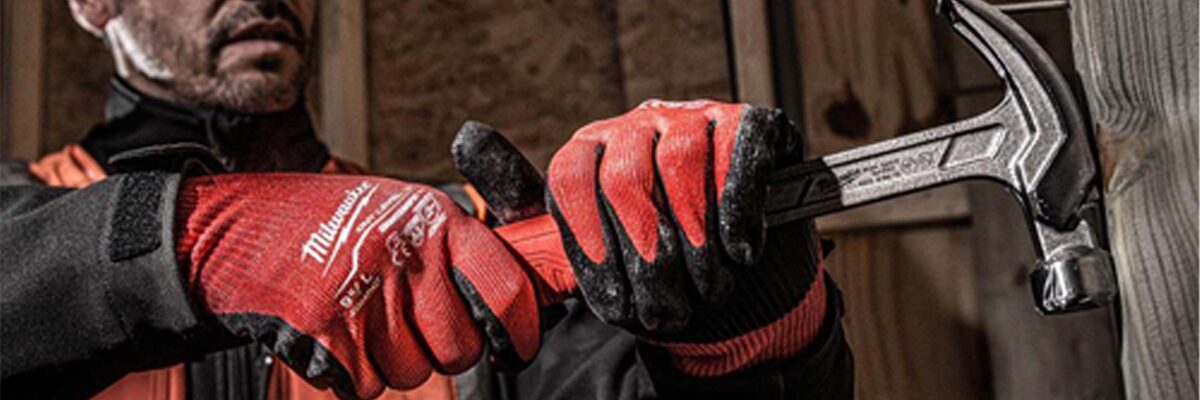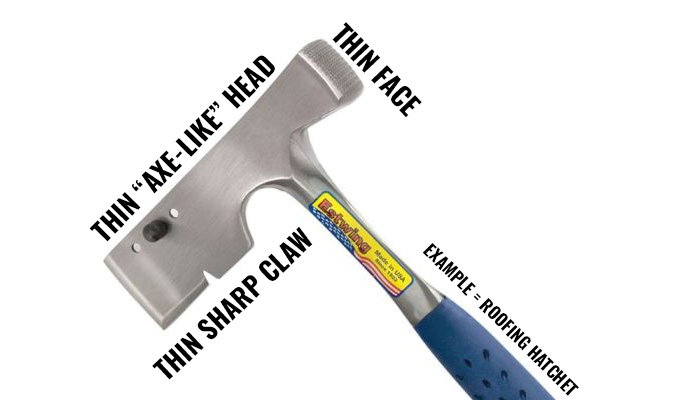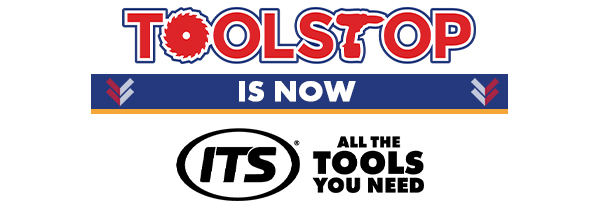
Hammers come in many shapes and sizes, some specialised and others general. In this article, we will explore the differences between an array of hammers, including;
- Claw Hammers
- Framing Hammers
- Roofing Hammers
- Stiletto Hammers
- Sledgehammers
- Brick Hammers
- Club Hammer / Lump Hammers
- Ball Pein Hammer / Ball Peen Hammers
- Deadblow Hammers
- Mallets
We will also explore what each hammer is good for, and why you should have one in your kit!
Hammers VS Mallets. What’s the difference?
Before starting, let’s get the easy question out of the way. Hammers have metal heads for driving nails or striking, while mallets have softer heads, often rubber or wood. You can also get nylon mallets too.
Metal = Hammer. Not Metal = Mallet. Simple right?
What are the different types of Hammers/Mallets?
Hammers come in various shapes and sizes so knowing which hammer to get for your specific job, will make you more efficient at the task at hand. The majority of hammer types can be identified based on these 3 criteria;
- The SHAPE of the hammer’s head (face and claw).
- The MATERIAL of the face, head, and claw.
- The LENGTH of the hammer’s handle.

The head spans the width of the top of the hammer, the face is the part of the hammer that is used to hit material and the claw is either used to pull nails, reshape metals, chisel materials, or in some cases act as another face. The handle allows you to operate the tool.
Below, we go into the different variations of hammers; each hammer type has a different type of handle, face, claw, or head, or all 4, and as such has a different name.
Building / Woodworking Hammers
What is a Claw Hammer?
A claw hammer has a flat head for driving nails and a curved, V-shaped claw for removing them. It’s a versatile tool for carpentry.

When you think of a hammer, 9 times out of 10, a claw hammer is the first to spring to mind. They’re used in woodworking and construction alike, and if you’re nailing something, this is the perfect tool. Over the years, claw hammers have been split further into separate categories such as electrician hammers, rip hammers/framing hammers, and finishing hammers. Whilst all could be called claw hammers, some do deserve their own category due to their differences
Claw Hammers can be used for:
- Driving nails into various materials.
- Removing nails with the curved claw.
- Carpentry and woodworking tasks.
- General household repairs.
- Framing and construction work.
Claw Hammer brands to look out for:
Notable claw hammer brands include Estwing, Vaughan, and Stanley. These brands make quality claw hammers for woodworking, DIY, and professional use.
What is a Framing Hammer?
A framing hammer is a popular type of claw hammer used in construction to drive long nails into wood.

The main difference between a regular claw hammer and a framing hammer is whilst having a similar body shape, the framing nail hammer will have a longer neck, heavier head, and, in some cases, a longer handle.
Framing hammers will also feature faces that are slightly curved or grooved, this gives the hammer a bit more grip, stopping nails from slipping when struck.
Framing hammers can be used for:
- Driving large nails into wooden frames.
- Constructing wooden structures, such as houses.
- Building fences and decks.
- Securing plywood or other sheet materials to frames.
- Fastening framing components during carpentry work.
Framing Hammer brands to look out for:
Estwing and Vaughan make excellent framing hammers but most brands have some sort of framing hammer, they’re just that popular!
What is a Roofing Hammer?
A roofing hammer is a tool used for nailing shingles onto roofs. It has a flat head for driving nails and a sharp, often single-tipped claw for removing and cutting roof material.

Roofing hammers come in many shapes and sizes and can be further categorised into slate hammers, roofing hatchets, roofing tailers, pick hammers, and roofing spades. Generally, they will have a flat metal head, a sharp pointed claw, and a short handle.
However, when getting more specific, tools like the roofing hatchet will start to get flatter and look more akin to an axe. They do, however, all keep their long single-pointed claw.

(example of a roofing hatchet)
Roofing Hammers can be used for;
- Nailing shingles onto a roof.
- Removing old or damaged shingles.
- Securing roofing felt or underlayment.
- Fastening flashing or metal components on the roof.
- Adjusting or aligning roofing materials during installation.
Roofing Hammer brands to look out for:
Estwing, Vaughan, and Rougheck are some good brands to look into when searching for a roofing hammer.
What is a Stiletto Hammer?
A Stiletto hammer is a lightweight framing hammer with a titanium head, designed for reduced weight and increased durability. It’s commonly used in construction for framing tasks.

Stiletto Hammers can be used for;
- Framing in construction work.
- Driving large nails or spikes.
- Achieving precision and control in framing tasks.
- Minimizing user fatigue due to lightweight titanium construction.
- High-performance framing applications in carpentry.
Stilleto Hammer brands to look out for:
Milwaukee makes a great stiletto hammer as seen here.
Masonry Hammers
What is a Sledgehammer?
A sledgehammer is a large, heavy hammer with a long handle, used for heavy-duty tasks like demolition or driving stakes.

Sledgehammers have a flat metal head, a flat face, and a flat “claw” which you could call a second face. Sledgehammers are usually heavy with long handles which allows them to be used to smash and demolish concrete and stone materials.
Sledgehammers can be used for:
- Demolition of walls or structures.
- Driving fence posts into the ground.
- Breaking up concrete paths.
- Shaping or forming metal.
- Forcing large objects apart.
Sledgehammer brands to look out for:
Ox Tools, Bulldog, and Roughneck make some amazing sledgehammers, with Ox Tools featuring fibreglass handled hammers. Depending on the job at hand, you can expect a sledgehammer from these brands to be around (7lb-14lb 3-8kg).
What is a Brick Hammer?
A brick hammer is a tool used for breaking and setting bricks. It has a chisel end for chipping and a blunt end for striking.

Brick hammers have a metal head, a flat face, and a chisel at the end, they also have a short handle making them lighter and more maneuverable. Often precision-balanced, brick hammers are used to cut bricks down to size with their chisel. The handles will also tend to have shock reduction built in to protect against the injuries caused by repetitive tasks.
Brick Hammers can be used for;
- Splitting bricks or stones.
- Shaping bricks or cutting them to size.
- Removing excess mortar from bricks.
- Setting or adjusting bricks in place.
- Tapping bricks into position without causing damage.
Brick Hammer Brands to look out for:
Marshalltown, Estwing, and Ox to name some brands. Ideally, you might want to go with a brand that offers shock absorption as these hammers are used often in bricklaying and construction.
What is a Club Hammer / Lump Hammer?
A club hammer, also known as a lump hammer, is a small, heavy hammer with a double-faced head. It’s used for light demolition and driving chisels.

Club hammers could be called the little brother (or sister) to the sledgehammer as they both serve the same purpose in that they’re used for demolishing stone and masonry. However, club hammers excel when used with a chisel.
The combination of the two tools allows you to be precise when “cracking” large blocks of stone down into smaller chunks. Club hammers can also be used in this way for sculpting. However, results may vary based on skill level.
Club Hammer / Lump Hammers can be used for;
- Light demolition work.
- Driving chisels or masonry drills.
- Breaking up small rocks or concrete.
- Setting stakes or anchors.
- General use in construction and landscaping.
Club Hammer / Lump Hammer brands to look out for:
Milwaukee, Estwing, and Stanley have decent ranges of club hammers to explore. With Milwaukee and Stanley also selling chisels, you could get yourself a nice branded set.
Automotive / Metal Hammers
What is a Ball Pein Hammer / Ball Peen Hammer?
A ball pein (or peen) hammer has a rounded face (opposite the flat face) and is used for shaping metal or closing rivets.

In the case of these hammers, the “claw” is called a pein or a peen. This spherical end is great for rounding off edges, in jobs such as metalworking. Another industry that uses this hammer en masse is the automotive industry, when repairing vehicles a ball pein hammer is the perfect tool to round off dents in bodywork.
Ball Pein Hammers can be used for;
- Shaping or forging metal.
- Closing or riveting metal joints.
- Peening or finishing metal surfaces.
- Driving punches or chisels in metalworking.
- Forming and shaping sheet metal.
Ball Pein Hammer brands to look out for:
Milwaukee, Stanley, and Estwing are well known for their ball pein hammer ranges, Milwaukee has been known to be at the forefront of automotive tools so it makes sense that their hand tool range includes such a specialist tool.
What is a Deadblow Hammer?
A dead blow hammer is a tool often filled with a steel shot to minimize rebound. The steel shot distributes the energy of each strike evenly. It’s designed for striking without causing damage or bounce-back. Commonly used in automotive and construction tasks.

Dead blow hammers are designed with heavier heads, which reduces kickback when striking surfaces. This means that when using the hammer it won’t rebound giving you control of the motion causing less accidental damage than say a rubber mallet.
Deadblow Hammers can be used for;
- Automotive and repair tasks where controlled impact is crucial.
- Installing or adjusting bearings.
- Minimizing rebound when striking.
- Preventing damage to delicate surfaces.
- Assembling or disassembling machinery.
- Installing or adjusting bearings.
Dead blow hammer brands to look out for:
Milwaukee has a great range of dead blow hammers built for automotive repairs and manufacture. Brands such as Estwing and Sealy also offer a range of pretty good hammers.
Mallets
What is a Mallet?
A mallet features soft faces, often made of rubber or plastic, for non-damaging blows. They can also be made of wood.

Mallets are a great tool for knocking wood into place when working with timber etc – think dovetail joints. They are also used to strike chisels and other woodworking tools, the advantage being that unlike metal tools they do not cause much damage to the tool they are hitting.
Mallets can be used for;
- Assembling furniture without damaging surfaces.
- Woodworking tasks like chiseling and carving.
- Shaping or forming metal with a non-damaging impact.
- Driving dowels or wooden joints together.
- Knocking components into place without causing damage.
Mallet brands to look out for:
Ox Tools has a great range of rubber mallets whereas brands such as Draper and Faithful will have you covered for wooden mallets.



